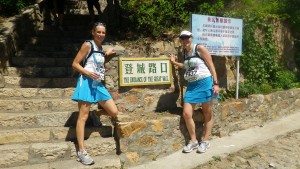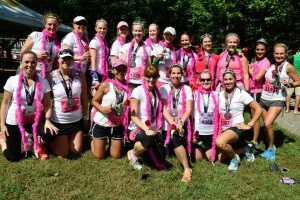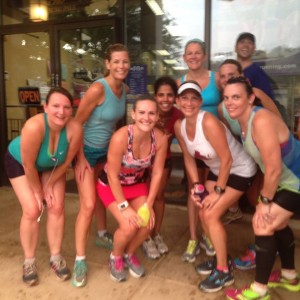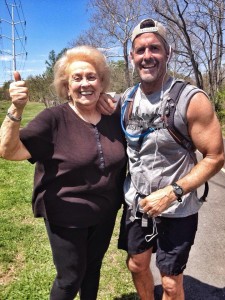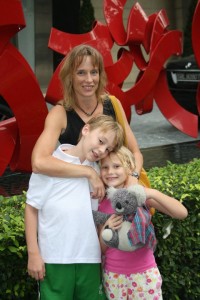 Endurance Runner Sarah Talley Tells Her Story of Globetrotting and How Running Is What Keeps Her Grounded
Endurance Runner Sarah Talley Tells Her Story of Globetrotting and How Running Is What Keeps Her Grounded
By Alix Shutello
The year was 2008, and Sarah Talley and her family were relocated to Singapore. Being in a strange location was not foreign to her, as Talley’s husband, Darrin, a fellow runner and Exxon Mobil executive, relocates the family every few years for his job. Talley, who had just finished her first marathon in Houston before they left the states, now needed something to keep her motivated. Like Houston, Singapore was hot and humid; Talley needed something to keep her focused on running, so while her children were in school, she trained for her next marathon. In 2009 she competed in the Sundown Marathon, a well-known international night race offering several distances including a marathon distance and an 84km distance (which was increased to 100km in 2011).
“I didn’t know anyone aside from one of the teachers from the school where our children attended. The teacher, however, was doing the ultra, or two marathons back to back, so he was already out on the course,” Talley explained. “One could say when I saw him I was truly amazed at his determination…and the wheels started turning about going farther one day.”
Talley caught the running bug back in 2003, when she completed her first half marathon. Even back then, she knew she wanted to go farther. With two marathons under her belt, she now looked to do another marathon but wanted to find running buddies, preferably other women, she could train with.
“Finding other women to run with became a priority after the Sundown race,” she said. “The Great Wall of China Adventure Race became my focus in 2010.”
With a new running partner to train with, the pair started to train on different terrains to prepare for the marathon.
“We would do very cool things to train for this race,” Talley said. “We would run six miles, then run high rises instead of hill repeats, and then continue on running. I enjoyed this crazy training more than any of the other training I had done for the past few races.”
The Great Wall of China Marathon changed Talley completely. Knowing now that there was more to running than races on pavement, she was hooked on finding other experiences to add to her running resume.
Talley’s family moved to Vienna, Va., in 2011 and she started looking for new running partners. She created her own group that would train around her neighborhood, but soon the group broke up. After doing some research, Talley found the organization, Moms Run This Town, a national consortium of moms who developed local chapters across the country to organize group runs of various distances and abilities. She called Pam Burrus, the organization’s founder, and decided to start a Vienna-Oakton chapter.
For Talley, finding a group of women is key to helping her settle after a move to a new location. She felt that starting the Vienna-Oakton chapter was the right thing to do. The chapter quickly grew from a few woman to now close to 1,000 members.
“The growth in the chapter meant that I was meeting a lot of new types of runners. I quickly became addicted to trail running, which is where I tend to train on most days. Trail running has sparked new enthusiasm in me and my running,” Talley said.
The interest in trail running has also allowed Talley to push farther, as she is now preparing for her first ultra-distance run, the Seashore Nature Trail 50k.
Sparking Interest in the Ragnar Relays
Talley’s dedication to MRTT has not only moved her to train for longer distance runs, but she is also a bona fide Ragnar junkie. Over the past few years, Talley has trained for a few Ragnar distance races, competing with teams who run through the nights – often to complete 200 miles over 24 hours. Now a Ragnar Relay Ambassador, Tally looks to build teams and compete in as many relays as she can.
Clothing and Style
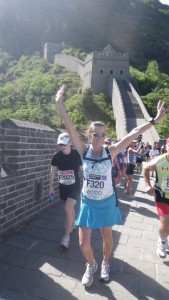 Talley also boasts a closet full of interesting running gear she’s tested and accumulated. Now a Sparkly Soul Headband Ambassador, “there is a lot of blue, green, orange, black and sparkle” in her wardrobe. Aside from that, Talley also leans toward Nike and Athlete bottoms for training and racing. “In the fall, I wear Nike Capris, a tank or short sleeves with arm warmers and sometimes gloves,” she said.
Talley also boasts a closet full of interesting running gear she’s tested and accumulated. Now a Sparkly Soul Headband Ambassador, “there is a lot of blue, green, orange, black and sparkle” in her wardrobe. Aside from that, Talley also leans toward Nike and Athlete bottoms for training and racing. “In the fall, I wear Nike Capris, a tank or short sleeves with arm warmers and sometimes gloves,” she said.
Talley has Raynaud’s disease, which causes some areas of your body – such as your fingers and toes – to feel numb and cold in response to cold temperatures or stress, so she tends to keep her gloves on for most of her training runs. On colder days, she uses Icebreaker for her base layer. Icebreaker, an environmentally conscious company that develops sustainable clothing out of sheep’s wool, put a table out on the WO&D Trail – an old railroad trail in the heart of Vienna where many of the MRTT weekend runs start – so that the moms could check out the clothes and the company.
Training for Maximum Impact
When it came to training, Talley had to make some adjustments in order to maintain a life balance. For some time, Talley would train with the moms on the weekends; but when she came home, her house was either empty, or she’d only cross paths with husband Darrin or her children, ages 13 and 10, who were headed out for their own training or weekend schedules.
After some thought and consulting with a fellow mom, Talley decided to stop training with the weekend warriors and change her focus so that she could spend more time with her family. She traded in Saturday training runs for family bike rides.
“I changed my training so that I would run Monday through Friday while my children were at school and my husband was at work,” she said.
Figuring out Nutrition for Her 50K
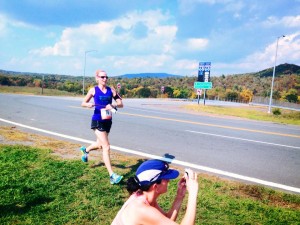 Figuring out a diet that works for Talley has been a challenge. After trying gus[C1] , gels and beans, Talley switch to real foods like pretzels, peanut butter sandwiches, and Fig Newtons when she was in Singapore, where American food products were hard to find. Back in the states, Talley has had success with Generation Ucan, Energy Bits and Accel gels. “I recently tried a Snickers bar near the end of a run and it gave me a boost for the last two miles, so I might try that again,” she said.
Figuring out a diet that works for Talley has been a challenge. After trying gus[C1] , gels and beans, Talley switch to real foods like pretzels, peanut butter sandwiches, and Fig Newtons when she was in Singapore, where American food products were hard to find. Back in the states, Talley has had success with Generation Ucan, Energy Bits and Accel gels. “I recently tried a Snickers bar near the end of a run and it gave me a boost for the last two miles, so I might try that again,” she said.
On Injury and What Motivates Her
Talley, who worked as a coach and personal trainer, follows her own advice when it comes to self-motivation and perseverance: “Smile, it makes it easier!” Another quote she keeps stored in her mind to use when training or in creating her artwork (Talley is an accomplished artist) is, “You are only limited by yourself.” In fact, Talley’s training runs have spawned some of the ideas she uses in her artwork.
Like many athletes, Talley has occasionally been sidelined by injury; but she takes it in stride. When the day comes that she cannot run around after her kids due to an injury, she said, she might throw in the towel.
“Being injured makes me reflect back at my training,” Talley explained.
]]>“I think I train smarter now; and most importantly, I try to listen to my body. As I venture into new distances and terrain, I continue to be a student in running – which I hope never changes.”

Mari Chandler, Team Tecnu
Mari Chandler, 38 of Lake Tahoe, NV, is an adventure racer who has literally carved her path in the sport. Chandler currently races on three adventure racing teams (Team Tecnu, Dart Nuun and Team Bones) – three of the top four teams in the U.S. She has travelled the world and loves every minute of adventure racing.
“On the fourth and final day of competition after you’ve been riding your bike 18 hours carrying a 25-lb. pack, you are tested as you carry both the bike and the pack up a steep and muddy hillside at 3 a.m. You know the penguins standing along the trail are just a hallucination, and oh yeah, it’s raining, and all you want to do is curl up into a ball and lay down because over the past four days, you’ve slept only three hours. And when the race is over, you think about the tough, miserable moments (and the exhilarating ones) and feel an amazing sense of accomplishment and satisfaction that cannot be duplicated in any other thing you do in your life.”
- Mari Chandler, Adventure Racer
Read her story in the upcoming Jan/Feb 2015 issue of Endurance Racing Magazine, coming out soon. To sign up for our free newsletter, click here. The story will only be available on our magazine. To subscribe for 6 issues for only $10, click here.
]]>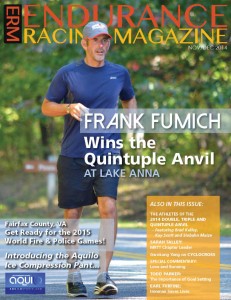 ON THE COVER: FRANK FUMICH
ON THE COVER: FRANK FUMICH
Frank Fumich won the Quintuple Anvil in a little over 105 hours. His race consisted swimming 7.2 miles, cycling 560 miles and running 131 miles. Fumich was trained by Lisa-Smith Batchen
of Dream Chasers
EDITOR’S LETTER
3 Coming Full Circle
After three years of covering the Lake Anna Anvil races, I’ve come away with a renewed sense of what it really takes to compete in these internationally-renown races.
RACING FOR A CAUSE
6 Kay Scott: Running for Dad
by Alix Shutello
Kay Scott of Bedford, TX travelled to Lake Anna, VA to complete at the Triple Anvil as a PDF Champion. This year, Scott’s goal was to raise awareness for her father’s rare form of Parkinson’s Disease.
COACHES CORNER
8 The Importance of Goal-Setting
By Todd Parker, M.A., M.S.
As the season comes to a close, take a moment to study how it went for you. If your performances were haphazard, irregular, and often void of improvement, perhaps your program is lacking the important component of goal-setting.
ATHLETE PROFILE
9 Winner of the 2014 Anvil Quintuple, Frank Fumich
Frank Fumich wanted to push himself a little—so he signed up to swim 12 miles, cycle 560 miles, and run 131 miles at Lake Anna State Park in Virginia this past October. It proved fruitful; Frank won!
10 Siobhan Maize, First Time Double Anvil Finisher
Siobhan Maize, age 43, competed in the Double Anvil race October 7-9 in Lake Anna, Va. This was Maize’s first attempt at an ultra-triathlon – and she came in as the first female.
RACE OVERVIEW
13 The Lake Anna Anvil Races
This year’s Double, Triple and Quintuple Anvil races were another success. Thanks to race director, Steve Kirby, for
putting on an amazing week of races.
FEATURES
18 Racing with Pain: Brad Kelley
By Alix Shutello
Brad Kelley, ultra triathlete, has overcome huge obstacles to compete. Kelley, who suffers from a chronic nerve condition, has had enormous success in some of the country’s toughest races
22 Endurance Runner, Sarah Talley, Tells Her Story of Globetrotting and How Running is What Keeps Her Grounded
By Alix Shutello
Sarah Talley, Vienna, Oakton Chapter Leader for Moms Run This Town, talks about training, racing, and balancing it all with her family life.
PRODUCT REVIEW
24 Catching Up with Chris McDonald
Chris McDonald of Big Sexy Racing touts Aquilo’s compression gear and recovery pump as some of his top equipment for
competition.
INTERNATIONAL RACE REPORTS | CHILE
26 Race Report: Inaugural Trail Torres del Paine, Chile
by Samuel Wild
The inaugural Trail Torres del Paine (109km distance) trail running event took place in the marvelous scenery of Torres del Paine National Park, Chile. The help of CONAF and other national institutions have made the organization of this event in such
a wonderful location possible.
28 Race Report: Patagonian International Marathon, Chile
by Samuel Wild
On September 27, 2014 the third edition of the Patagonian International Marathon officially ended last on a spectacular day in the majestic Torres del Paine National Park, recently voted as an eighth wonder of the world and located in Chile’s extreme south, the Magellan and Antarctic region.
IN FIRST PERSON
30 Getting Better at Cyclocross
By Gwokang Yang
At the end of August, when road race season ends, riders put away their road bikes and bring out their cyclocross bikes to start training for cyclocross race season. Cyclocross (or ’cross) races occur during the fall and winter months. In the beginning, the races were simply a way for road racers to stay in shape during the off-season; but ’cross has become its own sport and grown in popularity.
LOVE AND RUNNING
32 The Elephant in the Long Run
By Ryan Crosswell
Sometimes, we fall in love with our running partners. It’s heartbreaking, however, when only one’s heart is invested. Read Ryan’s very personal tale of love on the run.
NOT YET AT THE PODIUM
36 Ironman Saves Lives
By Earl Furfine
Tim Howard had a heart attack during and Ironman and kept going. Even those of us in exceptional shape still are prone to arterial blockages and the dangers that bring us close to the brink….but is the Ironman Tim’s savior?
SUBSCRIPTION INFORMATION
Subscribe today at EnduranceRacingMagazine.com
ENDURANCE RACING MAGAZINE
http://EnduranceRacingMagazine.com
https://www.facebook.com/EnduranceRacingMagazine
Twitter: @AlixShutello, @EndurRacingMag
Pinterest: http://pinterest.com/enduranceracing/boards/
<form action=”https://www.paypal.com/cgi-bin/webscr” method=”post” target=”_top”>
<input type=”hidden” name=”cmd” value=”_s-xclick”>
<input type=”hidden” name=”hosted_button_id” value=”L3DMRRNRB7YPQ”>
<input type=”image” src=”https://www.paypalobjects.com/en_US/i/btn/btn_subscribeCC_LG.gif” border=”0″ name=”submit” alt=”PayPal – The safer, easier way to pay online!”>
<img alt=”" border=”0″ src=”https://www.paypalobjects.com/en_US/i/scr/pixel.gif” width=”1″ height=”1″>
</form>
Coming Full Circle
By Alix J. Shutello
This issue is special to me. After three years of covering the Double, Triple and Quintuple Anvil races in Lake Anna, Virginia, I feel as if I was indoctrinated into a small community of superstars that are so unique in their athletic ability that it just stuns me. In fact, after observing many of these athletes in person or on Facebook where I was collecting photos, data, and other types of information I realized something profound.
What is a Double, Triple or Quintuple? It’s slang for distances past the Ironman, so a Double is a 2 times Ironman distance. A Triple is a 3 times Ironman distance, and a Quintuple is a 5 times Ironman distance.
In this issue, we cover a few of the athletes who competed in Lake Anna. Frank Fumich, who won the Quintuple Anvil race, will tell you that he does these types of races to push his personal boundaries. We at ERM want to dedicate this issue to Fumich who lost his mother, Marie Fumich, in October 2014, just weeks after the Anvil races. To Frank and his family, we share our deepest condolences.
We cover Anvil veterans Kay Scott and Brad Kelley, as well as Double Anvil newbie Siobhan Maize. ERM also wants to throw a shout out to the number-one internationally ranked Kamil Suran, whovolunteered the whole week at Lake Anna and went on to win the Monterrey, Mexico Deca Ultra this November.
To mix things up we have a few guest columns; one from Ryan Crosswell, an attorney and endurance athlete who tells a heart-wrenching tale about love and running. We also have another submission from our favorite cylco cross athlete, Gwokang Yang, who has done an excellent job at writing about the sport and how his fitness has increased through time. You will find his most recent race report exciting to say the least.
Now, onto another new section – for the last issue we introduced our new Regional section and covered DC Capital Striders founder, Rick Amernick. This issue, we are introducing endurance runner, Sarah Talley of Moms Run This Town, a national organization for which Talley has been an integral part of. In her story, we learn about how an athlete with experience running marathons in Asia, comes to states and becomes the founder of Virgina’s largest MRTT chapters. She is role model for all of us from the Vienna-Oakton chapter and beyond.
Also in new pieces we feature well known Ironman, Chris McDonald who founded Big Sexy. He wears a new type of compression gear developed by Aquio. This gear, meant for all types of athletes allows people to pull on compression pants which have veins which allow cold water to go through –so you get the feeling of ice and compression without sitting in icebath.
And finally, two of our long time contributing authors, Todd Parker and Earl Furfine contributed on special training and endurance topics. Parker covers the art of goal setting while Furfine describes the motivation and partnership of his long-time friend Tim Howard, who suffered a heart attack while in the water and continued on through his triathlon.
Thank you for your support! We hope you love this issue.
Not a subscriber? Click on the Buy Now button on the right side of the page for an annual subscription (6 issues).
Alix
]]>by Todd Parker, M.A., M.S.
 As the season comes to a close, take a moment to study how it went for you. If your performances were haphazard, irregular, and often void of improvement, perhaps your program is lacking the important component of goal-setting. Develop and focus on realistic but challenging goals. These goals start with long-term ones that might be one year/season, or more short-term goals that are generally months of culminating successes from the continually updating near-term goals that may be days to weeks. However, every workout or training session should have some sort of goal or goals – even if that goal is recovery. Without “stepping-stone” goals each week, you’ll lack focus, not know if or how much you’re improving, and your likelihood of achieving longer short-term and long-term goals is like rolling the dice.
As the season comes to a close, take a moment to study how it went for you. If your performances were haphazard, irregular, and often void of improvement, perhaps your program is lacking the important component of goal-setting. Develop and focus on realistic but challenging goals. These goals start with long-term ones that might be one year/season, or more short-term goals that are generally months of culminating successes from the continually updating near-term goals that may be days to weeks. However, every workout or training session should have some sort of goal or goals – even if that goal is recovery. Without “stepping-stone” goals each week, you’ll lack focus, not know if or how much you’re improving, and your likelihood of achieving longer short-term and long-term goals is like rolling the dice.
Rather than putting your dreams and goals into just hope and chance, focus on specific goals that will facilitate you reaching your optimal performance goals. There is no better way to do this than by having an outside professional (i.e., experienced, degreed, and certified coach) – with a non-emotional objective viewpoint – help guide you in goal establishment. If necessary, adjustments to those goals when life events and injury setbacks occur require another objective review. Bottom line, establishing goals and placing training and events in line with those goals will focus your training and position you to more often achieve optimal performances.
Plan for Success!
Todd Parker is a former Professional Triathlete, an Elite Cyclist, and Professor with a Masters in Exercise Physiology & Human Performance. Todd is also a exercise physiologist, certified cycling and endurance sports coach, strength coach, and personal trainer. You can reach Todd at [email protected] , 215.80.Coach (215.802.6224), or at his secure website https://toddparkertrainingprograms.com/
]]>
By Earl Furfine
![]()
![]()
![]() One of my favorite people on the planet – the man who was instrumental in the successful sale of my company in 2010 and, more importantly, was able to coach this somewhat capricious entrepreneur through some very difficult times – was almost lost to this world a few months ago. While racing a sprint triathlon at Longmont, Colo., my close friend and business advisor Tim Howard suffered a heart attack in the water. The Ironman-to-be (Arizona as planned November 16, 2014) finished the bike and even started the run, and THEN went to the medical tent.
One of my favorite people on the planet – the man who was instrumental in the successful sale of my company in 2010 and, more importantly, was able to coach this somewhat capricious entrepreneur through some very difficult times – was almost lost to this world a few months ago. While racing a sprint triathlon at Longmont, Colo., my close friend and business advisor Tim Howard suffered a heart attack in the water. The Ironman-to-be (Arizona as planned November 16, 2014) finished the bike and even started the run, and THEN went to the medical tent.
Tim has a lovely wife, Heidi, who I am honored to also call a friend. He has two wonderful children from a previous marriage – a son and daughter – and three beautiful young daughters from his current marriage. The world would be a much lesser place without his presence; and though that may seem trite, mundane, even colloquial, this is one of the cases where it actually applies. The number of lives this man has touched is immeasurable. A comment from a doctor in the ER proved to Tim one simple point: Had his fitness not been excellent with incredible cardiovascular strength, he would not be here. Quite simply, Ironman training saved his life.
Tim started exercising regularly in 2005, after going through a divorce and moving on from a company he had founded 10 years earlier. Prior to his first triathlon, he had been running marathons; and, like many motivated and goal-driven people, was looking for other challenges. For cross training purposes, he began to swim and bike. After several successful pool-based triathlons, he discovered that he had a severe open-water swimming phobia (countless people do), and failed at his first attempt at it. He had what he described as a panic attack in the water, and needed to turn back. Several years later and after a move to Boulder, Colo., he was compelled to conquer his fear – not just for himself but for his children, making a personal example of one Ironman Mantra: “Anything is possible.”
Underlying all of this, Tim had been watching Ironman for 20 years. For him, Ironman had always been an aspiration and something he viewed as truly heroic. He had always thought he would want to try one, but after his 2009 open water setback questioned whether could ever complete the 2.4-mile swim. In 2013, he was able to successfully complete his first open water swim, and signed up as a volunteer in 2013 for IM Arizona and planned to race in 2014.
When I asked Tim about the commitment to such a feat, he said he had fantastic support during his preparation and training and that his family viewed it as a “family accomplishment.” With three young children and Heidi’s successful photography career, it did create stress; but it also forced all of them to balance their lives. His plan surely was to make this a lifestyle choice, and not a “one and done”. Maybe not full IM, but the triathlons. His family understood the importance of their commitment, and he understood the responsibility of receiving that support.
In his most recent triathlon, Tim was in water for the warmup and thought he was having another panic attack. He was about 50M out and felt complete “impending doom,” as he put it, similar to the symptoms he had suffered years ago. He came to shore, got cleared by the medics (apparently this type of heart attack does not show up well on mobile EKGs, it requires bloodwork), and the race director indicated he could bike and run if he wished. With a “push through the fatigue and pain” attitude, Tim began to bike. He told me later that he had never felt such dead legs. He slowed down and cruised in on the bike, exhausted but still set on doing the run. One mile in on the run, he noticed his hands tingling (now is where we insert the “pay attention to these signs” lecture!).
Tim and Heidi went home to rest, and he literally felt like could not get up off the couch. Heidi decided it was time to get him to the ER. Moments after his arrival, his bloodwork confirmed he had – was having – a heart attack. With 90%-98% blockage in one of his arteries, the doctor assumed it closed down and perhaps opened back up during and after the swim. One cardiac catheterization and large stent catheterization later, Tim was about to begin his recovery. In no uncertain terms, the doctors attributed his still being on this earth to his great level of cardiovascular fitness. I shudder when I think of all the training he did with arterial blockage.
Post not-very-mortem: Tim is up to exercising an hour a day and is feeling very well. He is philosophical about his experience when I asked if he may try to complete a full IM. “Probably,” he said, “but it will be with respect to two items. First, it doesn’t really matter to me if I do a full IM because I already got the benefit of it. I am still alive. And second, I can’t embark on something that requires six-hour bike rides if my family will be worrying about me all day.” That does put things into perspective, doesn’t it? As a side note, Tim, a member of the Ironman Foundation, is planning on working with them to develop methods to identify panic attacks that are similar to heart attacks and not easily detectable.
I have said many times that everyone in life needs some sort of validation in the form of the one thing in their life they do only for themselves. I personally do Ironman because when I cross that finish line, I know I have accomplished something most people could never do. I never was the top scholar, top musician, top athlete, voted best-looking or any other superlatives. I do Ironman because Faith, Pace, Focus, and Strength have become my mantra and I, like Tim, am driven and goal-oriented. Tim likes to say, “I don’t like it when anyone tells me I can’t do something.” I strongly agree. What Tim has accomplished and I continue to strive for is that balance between family and racing. For Tim, overcoming open water was all about pushing through fear and convincing himself he can succeed. May all of us develop and maintain the wisdom to know there is something that you can’t push through, and recognize the signs when it happens.
I am, Not yet on the podium.
]]>
